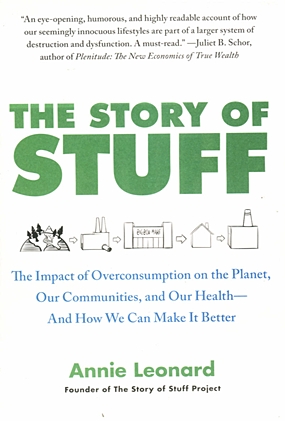“Stuff” is something our household has in copious amounts.
“Where is the stuff we use to clean the fridge,” is a familiar call. The
location is given as, “In with the other stuff, where you left it last
time.” That’s the beauty of the English language. It is so precise!

The Story of Stuff by Annie Leonard (ISBN
978-1-4516-1029-1, Free Press, 2011) attracted my eye on the Bookazine
shelves in Big C Extra, being personally so conversant with the “stuff” at
home. I should have looked further or read the sub-title at least, “The
impact of over-consumption on the planet, our communities, and our health -
and how we can make it better.”
Annie Leonard, it turns out, is a professional “greenie”,
having been an employee of Greenpeace before becoming one of Ralph Nader’s
raiders, then a member of the Global Alliance for Incineration Alternatives,
Healthcare without harm and the Sustainability Funders. This being the case,
I began reading with some trepidation.
Right from the beginning of the Introduction it was
obvious that Annie Leonard is an excellent writer, as the words flow
smoothly, but also obvious that Ms Leonard bases part of her thrust in the
trust that CO2 emissions must not go above 350 parts per million (ppm)
because “leading scientists” have said so. That’s my first stumbling block.
These “leading scientists” seem to be able to pull numbers out of a hat, or
rather, out of the air. With CO2 making up 0.03 percent of the earth’s
atmosphere, so with 99.97 percent left, I wonder if Ms Leonard is taking us
up a rather uncharted road?
Don’t go looking for solace in a cup of coffee, the book
suggests that it takes 36 gallons of water to make one cup of coffee and 256
gallons to make a T-shirt. I felt that I was about to be singled out as the
producer of drought.
And, profligate that I am, I regularly drink water,
adding to the six-fold increase in consumption in the last century, I am
informed. Mind you, how anyone can come up with figures for consumption 100
years ago, I do not know. But then, I’m not green.
A Utopian future is suggested by us showing “status” by
kindness, experience and wisdom, rather than a flashy car. I doubt I will
see that in my lifetime.
I am also sure that some of Ms. Leonard’s ideas are based
on good science, but unfortunately not practical.
At the back of the book are several pages of
acknowledgments including a group who had resisted oil and coal extraction
throughout the world, this being a plus in Ms. Leonard’s eyes. There is also
a sample letter you can use and send to any manufacturer of PVC products,
because of the toxicity involved. I’m sorry, I am still happy to buy my
sandwiches in film.
At B. 495 this book is exciting reading for the dedicated
green people. Last time I looked while in the shower, I remained a healthy
pink color, despite my sandwiches. I’m sorry, but The Story of Stuff
failed to win a convert here.

